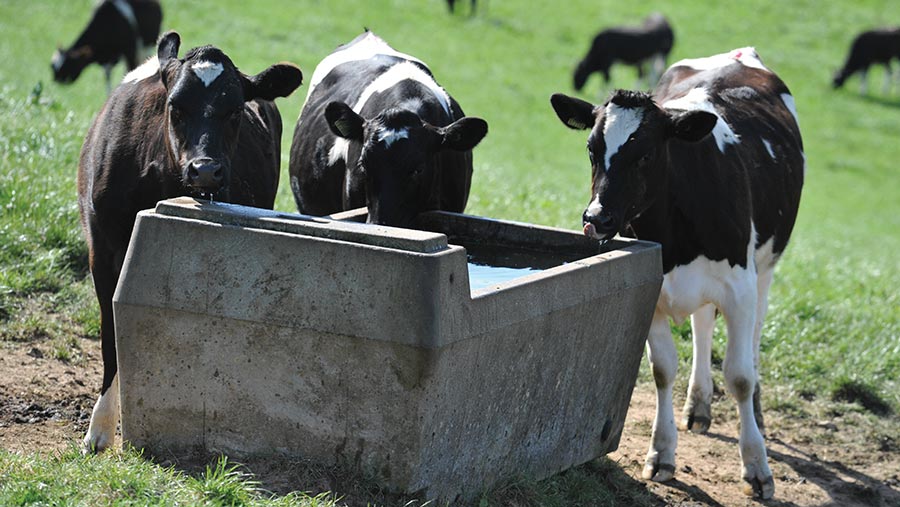Advice on testing and keeping water clean for livestock
 © Debbie James
© Debbie James A “control, check and clean” approach to managing water quality in cattle drinking troughs can encourage higher intakes and remove harmful bacteria.
Contaminated water will reduce intakes – with cattle put off by the taste and smell – as well as increasing the risk of disease.
Vet David Staak of Market Hall Vets, St Clears in Carmarthen, and Aled Davies of Pruex, a company that tests water quality, give their advice on how to ensure water is clean and palatable.
See also: 7 top tips for managing tracks and water when grazing stock to prevent poaching
Causes of contamination
Cattle drop food into troughs, and other organic material and faeces can also find their way into the water; these are all sources of harmful bacteria.
When the weather is warm, toxic algal blooms can also form.
While the trough is being used the water is replaced fast enough to prevent these blooms from developing, but problems occur when a field is vacant for two weeks or more.
Blue-green algae poisoning is relatively uncommon in the UK because long periods of hot weather are needed to stimulate bacterial growth, but a succession of hot summers is changing that, and poisoning could become a risk, warns Mr Staak.
Toxins produced by blue-green algae affect the nervous system and liver. Cattle experience muscle tremors, stagger, fall over, convulse, show shortness of breath.
The mucous membranes of the eye and mouth become a bluish-purple colour. Cattle often die shortly after this. Some cattle may become extremely sensitive to the effects of sunburn.
Other diseases spread by contaminated drinking water include leptospirosis, Johne’s, E coli and mycobacteria.
Water quality is adversely affected by biofilms that coat the inside of supply pipes and troughs. These build up over time and form a persistent reservoir for potentially pathogenic bacteria.
How to avoid contamination
- Ensure water troughs can be emptied and cleaned out frequently.
- Check them regularly for signs of algae and slime.
- In fields that have not been grazed for a while, empty and clean troughs before returning cattle to the field.
- During warm weather cover troughs when fields are not occupied, if possible.
- Positioning troughs in a shady spot can help, but if they are placed under trees organic matter will fall in the water and can add to the problem.
- A novel approach is to put goldfish in troughs to minimise algal growth – this can be useful if troughs cannot be easily emptied and scrubbed, although they should be removed in the winter as they will not survive the cold.
- Biofilms can be tested by swabbing pipes, troughs and boreholes to establish which bacteria are present. “Good” bacteria can then be introduced to combat harmful biofilm-forming micro-organisms. Mr Davies says: “Bacteria in water doubles every 20 minutes and as the population of good bacteria grows they weaken the biofilm and occupy the voids left by the harmful bacteria.”
Cleaning – best techniques
- To reduce concentrations of coliform bacteria, drain the old water from the trough and scoop out remaining debris.
- Most disinfectants are suitable for cleaning but only if troughs are thoroughly rinsed before they are refilled.
- Use clean water applied with a pressure washer to avoid any residues from disinfectants tainting the water.
How can I test for the cleanliness of water?
Annual testing for pH, nitrates, sulphates and total dissolved solids (TDS) – the inorganic contaminants in water – is recommended.
To test, use clean containers and collect eight, one-pint samples at random intervals. Mix in a container and send off to a lab for analysis (ask your vet).
Recommendations:
- The pH should be between 6.0 and 9.0 for most livestock species
- TDS content of less than 1,000 parts per million (ppm) is ideal for dairy cows, but levels below 3,000ppm are generally considered safe to drink
- For nitrates, below 20ppm is recommended
- The maximum sulphate level should be less than 1,000ppm for adult animals and less than 500 for calves.
Nutritional additives
Adding minerals to water is contentious because intakes vary according to rainfall and climate.
For example, in very hot weather cows may drink a lot of water and consume too much of the mineral, while very wet weather may result in under-consumption.
Mr Staak favours adding minerals to feed instead, and says adding magnesium in the spring and autumn will help prevent staggers.
If a soluble source of magnesium is chosen its level can be monitored through the colour of the water. The water turns blue when you add the magnesium and then gradually becomes clear again as the magnesium is depleted.
Magnesium flakes can also be included at a rate of 125g per 100 litres of water. Care should taken to prevent adding too much mineral because it can result in cattle refusing to drink the water.
